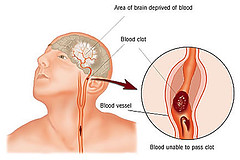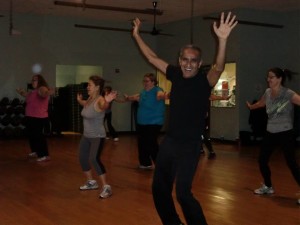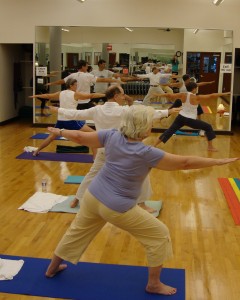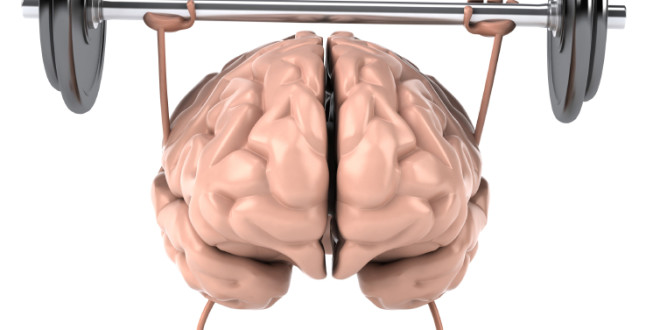by Michelle Sutton-Kerchner
May is National Stroke Awareness Month. Learn how to prevent a stroke and recognize symptoms with these lifesaving tips …
 Stroke is a leading cause of death in the United States. With timely response, serious outcomes can be avoided and sometimes completely prevented. A stroke stops, or dangerously reduces, the supply of blood and oxygen to the brain. Within minutes, brain cells begin to die. Although a stroke is a direct attack on the brain, it affects the entire body.
Stroke is a leading cause of death in the United States. With timely response, serious outcomes can be avoided and sometimes completely prevented. A stroke stops, or dangerously reduces, the supply of blood and oxygen to the brain. Within minutes, brain cells begin to die. Although a stroke is a direct attack on the brain, it affects the entire body.
The effects can be mild to severe and include paralysis, cognitive issues, impaired speech, memory loss, trouble swallowing, impulsiveness, and emotional struggles. Pain or numbness is sometimes present after a stroke, as well. Typically, a stroke occurs on either the right or left side of the brain, with the opposite side of the body affected.
A stroke can occur at any age, to any race or gender. Some individuals are at higher risk because of lifestyle, medical factors, or a combination of both. With proper medical intervention and healthy living, stroke risk can be greatly reduced. Up to 80 percent of strokes can be prevented. Indeed, knowledge is power.
Are You Susceptible?
Medical risk factors for stroke include high blood pressure, atrial fibrillation, high cholesterol, diabetes, atherosclerosis, and circulation problems. These risks should be managed under the guidance of a physician.
A person can control lifestyle risk factors by adopting healthy habits, which often decrease medical risk factors as well. Lack of exercise and other physical activity, obesity, tobacco use, and heavy alcohol consumption put one at greater risk for stroke. They also contribute to risks that require medical intervention to fix.
Lower It
Keep weight, cholesterol, and blood pressure numbers healthy with exercise and proper nutrition. This also lowers your risk of diabetes and circulation issues. Those who exercise five or more times weekly reduce their stroke risk. Those who live a sedentary lifestyle may possibly triple their risk for stroke, according to one report by the Argentine Heart Foundation (FCA).

Get healthy blood flow throughout your body with a heart-pumping cardio workout. Try to manage 30 minutes daily of exercise and physical activity. It can be accomplished in 10- or 15-minute segments on hectic days when you cannot visit the Center. (Spring yard work counts!) If new to exercise, get a routine physical first and start gradually. Consider cycling, swimming, walking, and cardio-focused Group Fitness classes.
Research indicates older adults who exercise regularly are less likely to suffer a silent stroke. A silent stroke can indicate an increased risk for a full-blown stroke. Although this predisposition shouldn’t be ignored, by nature, a silent stroke goes unnoticed with its subtle memory loss and mobility issues. Lower the risk!
Memorize It
FAST is the acronym of stroke warning signs. Within three hours of symptom onset, an FDA-approved clot-buster medication may be administered. This can reduce long-term disability from Ischemic strokes, the most common type. One drug, called t-PA, dissolves blood clots that obstruct blood flow to the brain. There are also other helpful medications.
The most effective stroke treatments only are available if the stroke is diagnosed within the first three hours of the first symptoms. Beyond three hours, patients may not be eligible for stroke treatments, which otherwise could have reversed the stroke entirely. Recognize these symptoms and act FAST.
Face: Ask the person to smile. Does one side of the face droop?
Arms: Ask the person to raise both arms. Does one arm drift downward?
Speech: Ask the person to repeat a simple phrase. Is his/her speech slurred?
Time: Act fast. If you observe any of these symptoms, immediately call 911. Note the time.
Symptoms:
- Sudden weakness or numbness in face (facial paralysis), arm, or leg, especially on one side of the body
- Loss of speech, trouble talking or understanding speech, confusion
- Sudden dimness, blurring, or loss of vision, particularly in one eye
- Sudden, severe headache with no apparent cause
- Unexplained dizziness, unsteadiness, loss of balance (a sudden fall) or coordination
For a FAST reminder card to keep in your wallet, visit www.stroke.org at www.stroke.org/site/PageServer?pagename=SYMP.
Women may also report unique symptoms, which include sudden onset of: face and limb pain, hiccups, nausea, general weakness, chest pain, shortness of breath, palpitations.
Avoid Recurrent Stroke
At least 1 in 4 of the 795,000 Americans who have a stroke each year will have another stroke within their lifetime. Within the first five years following a stroke, the risk for a recurrent stroke can increase more than 40 percent. Consequences may be more severe with recurrent strokes because the brain was previously injured.
Depending on the degree of recovery, stroke victims can and should incorporate appropriate physical activity into their daily lives. By increasing metabolic activity in the brain, exercise helps it effectively rewire itself around any damage caused by the stroke. Exercise is defined as anything requiring physical exertion for a healthy outcome. For a stroke victim, physical exertion may be the simple act of raising a leg or squeezing a hand.
Immediately following a stroke, a person can struggle with voluntary control over the affected side of the body. Passively moving body parts through available range-of-motion keeps muscles flexible and prevents joints from stiffening. This movement is critical to prevent painful, counterproductive aches and pains during rehabilitation and beyond.

Balance work done through gentle yoga or Pilates is often helpful. Control of one’s trunk may have been affected during a stroke. The trunk needs to regain strength. Accomplish this by using props when necessary, such as exercise balls, canes, parallel bars, and walkers. If movement is severely limited, exercising while seated helps coordination and circulation.
Once rehabilitation is complete, a personal trainer can advise on next steps based on previous progress and physician recommendations. A trainer also can work with a physical therapist during the transition from therapeutic to functional exercise. Open communication between healthcare and fitness teams assures appropriate, safe exercise programs.
Modifications can be made and limitations overcome. When ready, treadmill workouts can be successful in helping stroke victims advance their exercise program. They provide a simple, controlled method of movement.
An article published in NeuroRehabilitation indicated individuals with muscle weakness from strokes who participated in strength training workouts significantly increased muscle power. This was accomplished without negative effects on post-stroke spastic muscles. As muscles strengthened, these contractions lessened. With proper guidance, weightlifting can be helpful.
Customized exercises can assist in gaining mobility and confidence. Recovery from a stroke is an individualized process, depending on the stroke’s severity and treatment success. Being as active as possible, although sometimes challenging, is part of every stroke recovery and prevention plan.
Do Your Part
Get healthier and help others do the same. Consider using your own efforts at prevention to create a healthier community. As you work to decrease personal risk factors, get in shape to help lower those of others. Train to participate in events sponsored by the National Stroke Association.
These events inspire survivors in their recovery; increase prevention by educating the public; and help accomplish fitness goals, regardless of stroke susceptibility. For those personally familiar with the dangers of stroke through loved ones, participation in a competitive event helps diminishes the common feelings of helplessness. It is also a positive outlet for caregivers.
The National Stroke Association is a charity partner with three upcoming athletic events in New York City: 2014 TD Bank Five Boro Bike Tour (May 4); 2014 NYC Triathlon (August 3); 2014 TCS NYC Marathon (November 2). Ready for the challenge? Speak with a personal trainer about how you can prepare.
Determine your susceptibility and manage your risk factors for stroke. Know how to identify symptoms, FAST. You could save a life, including your own.
Sources
www.strokeassociation.org
Images
Stroke sketch: https://www.flickr.com/photos/charliebrown8989/139741746
 Fitness & Wellness News Your Source for Fitness News, Wellness News, Health News, and Nutrition News!
Fitness & Wellness News Your Source for Fitness News, Wellness News, Health News, and Nutrition News!




